Multi-Temporal Relative Sea Level Rise Scenarios up to 2150 for the Venice Lagoon (Italy)
Abstract
1. Introduction
Geodynamic Setting and Land Subsidence in the Venice Lagoon
2. Materials and Methods
2.1. Geodetic Analysis
VLM from GNSS Data
2.2. InSAR Analysis
2.3. EPS Analysis
2.4. Tide Gauge Analysis
2.5. High-Resolution Digital Surface Models (DSMs)
3. Results
3.1. Relative Sea Level Rise Projections
3.2. Flooding Scenarios for 2050, 2100, and 2150
3.2.1. Area 1—The City of Venice
3.2.2. Area 2—St. Erasmo Island
3.2.3. Area 3—The Marco Polo Airport
3.2.4. Areas 4, 5, and 6—The MoSE Barriers at the Lido, Malamocco, and Chioggia Inlets
3.2.5. Area 7—Marghera Harbor
3.2.6. Areas 8, 9, and 10—The Lido Coastal Zone (Venice, Pellestrina, and Cavallino)
3.2.7. Area 11—Chioggia
4. Discussion
Implications for the MoSE System
5. Conclusions
Supplementary Materials
Author Contributions
Funding
Data Availability Statement
Acknowledgments
Conflicts of Interest
Abbreviations
| AR6 | Sixth Assessment Report |
| CO.RI.LA | Consortium for the coordination of research relating to the Venice lagoon system |
| DEM | Digital Elevation Model |
| DS | distributed scatterer |
| DSM | Digital Surface Model |
| EPS | Enhanced Permanent Scatterer |
| FE | flooding extension |
| GIA | Glacial Isostatic Adjustment |
| GNSS | Global Navigation Satellite System |
| InSAR | Interferometric Synthetic Aperture Radar |
| IPCC | Intergovernmental Panel on Climate Change |
| LiDAR | Light Detection And Ranging |
| LS | land subsidence |
| MHWL | Maximum High Water Level |
| MoSE | Modulo Sperimentale Elettromeccanico |
| MSL | mean sea level |
| MT-InSAR | Multi-Temporal Interferometric Synthetic Aperture Radar |
| PS | Permanent Scatterers |
| RSLR | relative sea level rise |
| SAR | Synthetic Aperture Radar |
| SB | Small Baseline |
| SL | sea level |
| SLR | sea level rise |
| SSP | Shared Socioeconomic Pathway |
| UNESCO | United Nations Educational, Scientific and Cultural Organization |
| VLM | Vertical Land Movement |
| ZMPS | Zero Mean sea level at Punta della Salute tide gauge station |
References
- Doglioni, C. Some remarks on the origin of foredeeps. Tectonophysics 1993, 228, 1–20. [Google Scholar] [CrossRef]
- Canal Ernesto. Archeologia Della Laguna di Venezia; Cierre Edizioni: Sommacampagna, Italy, 2013; ISBN 9788883147906. [Google Scholar]
- City of Venice. Yearbook of Tourism Data 2019. City of Venice Tourism Department. 2021. Available online: https://www.comune.venezia.it/it/content/studi (accessed on 20 October 2022).
- Zanchettin, D.; Bruni, S.; Raicich, F.; Lionello, P.; Adloff, F.; Androsov, A.; Antonioli, F.; Artale, V.; Carminati, E.; Ferrarin, C.; et al. Sea-level rise in Venice: Historic and future trends (review article). Nat. Hazards Earth Syst. Sci. 2021, 21, 2643–2678. [Google Scholar] [CrossRef]
- Lionello, P.; Barriopedro, D.; Ferrarin, C.; Nicholls, R.J.; Orlić, M.; Raicich, F.; Reale, M.; Umgiesser, G.; Vousdoukas, M.; Zanchettin, D. Extreme floods of Venice: Characteristics, dynamics, past and future evolution (review article). Nat. Hazards Earth Syst. Sci. 2021, 21, 2705–2731. [Google Scholar] [CrossRef]
- Lionello, P.; Nicholls, R.J.; Umgiesser, G.; Zanchettin, D. Venice Flooding and Sea Level: Past Evolution, Present Issues, and Future Projections (Introduction to the Special Issue). Nat. Hazards Earth Syst. Sci. 2021, 21, 2633–2641. [Google Scholar] [CrossRef]
- Vecchio, A.; Anzidei, M.; Serpelloni, E.; Florindo, F. Natural variability and vertical land motion contributions in the mediterranean sea-level records over the last two centuries and projections for 2100. Water 2019, 11, 1480. [Google Scholar] [CrossRef]
- Carbognin, L.; Gambolati, G.; Johnson, A.I. (Eds.) Land Subsidence: Proceedings of the Sixth International Symposium on Land Subsidence; C.N.R.: Ravenna, Italy, 2000; Volume I–II. [Google Scholar]
- Cuffaro, M.; Riguzzi, F.; Scrocca, D.; Antonioli, F.; Carminati, E.; Livani, M.; Doglioni, C. On the geodynamics of the northern Adriatic plate. Rendiconti Lince Sci. Fis. Nat. 2010, 21, 253–279. [Google Scholar] [CrossRef]
- Falciano, A.; Anzidei, M.; Greco, M.; Trivigno, M.L.; Vecchio, A.; Georgiadis, C.; Patias, P.; Crosetto, M.; Navarro, J.; Serpelloni, E.; et al. The SAVEMEDCOASTS-2 webGIS: The Online Platform for Relative Sea Level Rise and Storm Surge Scenarios up to 2100 for the Mediterranean Coasts. J. Mar. Sci. Eng. 2023, 11, 2071. [Google Scholar] [CrossRef]
- Oppenheimer, M.; Bruce, G.; Jochen, H.; van de Wal, R.S.W.; Alexandre, A.; Abd-Elgawad, A.; Cai, R.; Cifuentes-Jara, M.; de Conto, R.; Tuhin, G.; et al. Sea Level Rise and Implications for Low Lying Islands, Coasts and Communities. In IPCC Special Report on the Ocean and Cryosphere in a Changing Climate; Pörtner, H.-O., Roberts, D.C., Masson-Delmotte, V., Zhai, P., Tignor, M., Poloczanska, E., Mintenbeck, K., Alegría, A., Nicolai, M., Okem, A., Eds.; IPCC: Geneva, Switzerland, 2019. [Google Scholar]
- Frederikse, T.; Landerer, F.W.; Caron, L.; Adhikari, S.; Parkes, D.; Humphrey, V.; Dangendorf, S.; Hogarth, P.; Zanna, L.; Cheng, L.; et al. The causes of sea-level rise since 1900. Nature 2020, 584, 393–397. [Google Scholar] [CrossRef]
- Mitrovica, J.X.; Tamisiea, M.E.; Davis, J.L.; Milne, G.A. Recent mass balance of polar ice sheets inferred from patterns of global sea-level change. Nature 2001, 409, 1026–1029. [Google Scholar] [CrossRef] [PubMed]
- Lambeck, K.; Woodroffe, C.D.; Antonioli, F.; Anzidei, M.; Gehrels, W.R.; Laborel, J.; Wright, A.J. Paleoenvironmental Records, Geophysical Modeling, and Reconstruction of Sea-Level Trends and Variability on Centennial and Longer Timescales. In Understanding Sea-Level Rise and Variability; Blackwell: Hoboken, NJ, USA, 2010; pp. 61–121. [Google Scholar]
- Lambeck, K.; Antonioli, F.; Anzidei, M.; Ferranti, L.; Leoni, G.; Scicchitano, G.; Silenzi, S. Sea level change along the italian coast during the Holocene and projections for the future. Quat. Int. 2011, 232, 250–257. [Google Scholar] [CrossRef]
- Jevrejeva, S.; Williams, J.; Vousdoukas, M.I.; Jackson, L.P. Future sea level rise is driving the worst case for extreme sea levels along the global coastline by 2100. Environ. Res. Lett. 2023, 18, 024037. [Google Scholar] [CrossRef]
- Fox-Kemper, B.; Hewitt, H.T.; Xiao, C.; Aðalgeirsdóttir, G.; Drijfhout, S.S.; Edwards, T.L.; Golledge, N.R.; Hemer, M.; Kopp, R.E.; Krinner, G.; et al. Ocean, Cryosphere, and Sea Level Change. In Climate Change: The Physical Science Basis. Contribution of Working Group I to the Sixth Assessment Report of the Intergovernmental Panel on Climate Change, Masson-Delmotte, V., Zhai, P., Pirani, A., Eds.; Cambridge University Press: Cambridge, UK, 2021. [Google Scholar]
- Cianflone, G.; Tolomei, C.; Brunori, C.A.; Dominici, R. InSAR Time Series Analysis of Natural and Anthropogenic Coastal Plain Subsidence: The Case of Sibari (Southern Italy). Remote Sens. 2015, 7, 16004–16023. [Google Scholar] [CrossRef]
- Anzidei, M.; Scicchitano, G.; Scardino, G.; Bignami, C.; Tolomei, C.; Vecchio, A.; Serpelloni, E.; De Santis, V.; Monaco, C.; Milella, M.; et al. Relative Sea-Level Rise Scenario for 2100 along the Coast of South Eastern Sicily (Italy) by InSAR Data, Satellite Images and High-Resolution Topography. Remote Sens. 2021, 13, 1108. [Google Scholar] [CrossRef]
- Shirzaei, M.; Bürgmann, R. Global climate change and local land subsidence exacerbate inundation risk to the San Francisco Bay Area. Sci. Adv. 2018, 4, eaap9234. [Google Scholar] [CrossRef]
- Brunori, C.A.; Murgia, F. Spatiotemporal Evolution of Ground Subsidence and Extensional Basin Bedrock Organization: An Application of Multitemporal Multi-Satellite SAR Interferometry. Geosciences 2023, 13, 105. [Google Scholar] [CrossRef]
- Doglioni, C. The Venetian Alps Thrust Belt. In Thrust Tectonics; McClay, K.R., Ed.; Chapman & Hall: London, UK, 1992; pp. 319–324. [Google Scholar]
- Doglioni, C.; Carminati, E. Structural styles and Dolomites field trip. Mem. Descr. Della Carta Geol. 2008, 82, 1–299. [Google Scholar]
- Gatto, P.; Carbognin, L. The Lagoon of Venice: Natural environmental trend and man-induced modification/La Lagune de Venise: L’évolution naturelle et les modifications humaines. Hydrol. Sci. Bull. 1981, 26, 379–391. [Google Scholar] [CrossRef]
- Pirazzoli, P.A. Sea Level Changes, The Last 20,000 Years; John Wiley & Sons: Hoboken, NJ, USA, 1996; p. 1996. [Google Scholar]
- Fontes, J.C.; Bortolami, G. Subsidence of the Venice Area During the Past 40,000 ys. Nature 1973, 244, 339–341. [Google Scholar] [CrossRef]
- Carbognin, L.; Teatini, P.; Tosi, L. Eustacy and land subsidence in the Venice Lagoon at the beginning of the new millennium. J. Mar. Syst. 2004, 51, 345–353. [Google Scholar] [CrossRef]
- Arca, S.; Beretta, G.P. Prima sintesi geodetico-geologica sui movimenti verticali del suolo nell’Italia Settentrionale (1897–1957). Boll. Geod. Sci. Aff. 1985, 44, 125–156. [Google Scholar]
- Carminati, E.; Di Donato, G. Separating natural and anthropogenic vertical movements in fast subsiding areas: The Po plain (N. Italy) case. Geophys. Res. Lett. 1999, 26, 2291–2294. [Google Scholar] [CrossRef]
- Fontana, A.; Vinci, G.; Tasca, G.; Mozzi, P.; Vacchi, M.; Bivi, G.; Salvador, S.; Rossato, S.; Antonioli, F.; Asioli, A.; et al. Hajdas, Lagoonal settlements and relative sea level during Bronze Age in Northern Adriatic: Geoarchaeological evidence and paleogeographic constraints. Quat. Int. 2017, 439, 17–36. [Google Scholar] [CrossRef]
- Tosi, L.; Carbognin, L.; Teatini, P.; Strozzi, T.; Wegmüller, U. Evidence of the present relative land stability of Venice, Italy, from land, sea, and space observations. Geophys. Res. Lett. 2002, 29, 3-1–3-4. [Google Scholar] [CrossRef]
- Serpelloni, E.; Cavaliere, A.; Martelli, L.; Pintori, F.; Anderlini, L.; Borghi, A.; Randazzo, D.; Bruni, S.; Devoti, R.; Perfetti, P.; et al. Surface velocities and strain-rates in the Euro-Mediterranean region: From massive GPS data processing. Front. Earth Sci. 2022, 10, 907897. [Google Scholar] [CrossRef]
- Massonnet, D.; Feigl, K.; Rossi, M.; Adragna, F. Radar interferometric mapping of deformation in the year after the Landers earthquake. Nature 1994, 369, 227–230. [Google Scholar] [CrossRef]
- Zebker, H.A.; Villasenor, J. Decorrelation in interferometric radar echoes. IEEE Trans. Geosci. Remote Sens. 1992, 30, 950–959. [Google Scholar] [CrossRef]
- Chen, C.W.; Zebker, H.A. Network approaches to two-dimensional phase unwrapping: Intractability and two new algorithms: Erratum. J. Opt. Soc. Am. A 2001, 18, 1192. [Google Scholar] [CrossRef]
- Ferretti, A.; Prati, C.; Rocca, F. Permanent scatterers in SAR interferometry. IEEE Trans. Geosci. Remote Sens. 2001, 39, 8–20. [Google Scholar] [CrossRef]
- Ferretti, A.; Fumagalli, A.; Novali, F.; Prati, C.; Rocca, F.; Rucci, A. A New Algorithm for Processing Interferometric Data-Stacks: SqueeSAR. IEEE Trans. Geosci. Remote. Sens. 2011, 49, 3460–3470. [Google Scholar] [CrossRef]
- Berardino, P.; Fornaro, G.; Lanari, R.; Sansosti, E. A new algorithm for surface deformation monitoring based on small baseline differential SAR interferograms. IEEE Trans. Geosci. Remote. Sens. 2002, 40, 2375–2383. [Google Scholar] [CrossRef]
- Hooper, A. A multi-temporal InSAR method incorporating both persistent scatterer and small baseline approaches. Geophys. Res. Lett. 2008, 35, 16. [Google Scholar] [CrossRef]
- Crosetto, M.; Monserrat, O.; Cuevas-González, M.; Devanthéry, N.; Crippa, B. Persistent Scatterer Interferometry: A review. ISPRS J. Photogramm. Remote Sens. 2016, 115, 78–89. [Google Scholar] [CrossRef]
- Hooper, A.; Bekaert, D.; Spaans, K.; Arıkan, M. Recent advances in SAR interferometry time series analysis for measuring crustal deformation. Tectonophysics 2012, 514-517, 1–13. [Google Scholar] [CrossRef]
- Casu, F.; Manzo, M.; Lanari, R. A quantitative assessment of the SBAS algorithm performance for surface deformation retrieval from DInSAR data. Remote Sens. Environ. 2006, 102, 195–210. [Google Scholar] [CrossRef]
- Ferrarin, C.; Lionello, P.; Orlić, M.; Raichic, F.; Salvadori, G. Venice as a paradigm of coastal flooding under multiple compound drivers. Sci. Rep. 2022, 12, 5754. [Google Scholar] [CrossRef] [PubMed]
- Barzaghi, R.; Borghi, A.; Carrion, D.; Sona, G. Refining the estimate of the Italian quasi-geoid. Boll. Geod. E Sci. Affin. 2007, 66, 145–159. [Google Scholar]
- Albertella, A.; Barzaghi, R.; Carrion, D.; Maggi, A. The joint use of gravity data and GPS/levelling undulations in geoid estimation procedures. Boll. Geod. E Sci. Affin. 2008, 67, 49–59. [Google Scholar]
- Yunus, A.P.; Avtar, R.; Kraines, S.; Yamamuro, M.; Lindberg, F.; Grimmond, C.S.B. Uncertainties in Tidally Adjusted Estimates of Sea Level Rise Flooding (Bathtub Model) for the Greater London. Remote Sens. 2016, 8, 366. [Google Scholar] [CrossRef]
- Gallien, T.W.; Sanders, B.F.; Flick, R.E. Urban Coastal Flood Prediction: Integrating Wave Overtopping, Flood Defenses and Drainage. Coast. Eng. 2014, 91, 18–28. [Google Scholar] [CrossRef]
- Cavaleri, L.; Bajo, M.; Barbariol, F.; Bastianini, M.; Benetazzo, A.; Bertotti, L.; Chiggiato, L.; Ferrarin, C.; Umgiesser, G.; Trincardi, F. The 2019 Flooding of Venice and Its Implications for Future Predictions. Oceanography 2020, 33, 42–49. [Google Scholar] [CrossRef]
- Seenath, A.; Wilson, M.; Miller, K. Hydrodynamic versus GIS Modelling for Coastal Flood Vulnerability Assessment: Which Is Better for Guiding Coastal Management? Ocean Coast. Manag. 2016, 120, 99–109. [Google Scholar] [CrossRef]
- Anderson, T.R.; Fletcher, C.H.; Barbee, M.M.; Romine, B.M.; Lemmo, S.; Delevaux, J.M.S. Modeling Multiple Sea Level Rise Stresses Reveals up to Twice the Land at Risk Compared to Strictly Passive Flooding Methods. Sci. Rep. 2018, 8, 14484. [Google Scholar] [CrossRef] [PubMed]
- Gao, X.-J.; Wang, X.-Y. Impacts of Global Warming and Sea Level Rise on Service Life of Chloride-Exposed Concrete Structures. Sustainability 2017, 9, 460. [Google Scholar] [CrossRef]
- Vacchi, M.; Marriner, N.; Morhange, C.; Spada, G.; Fontana, A.; Rovere, A. Multiproxy assessment of Holocene relative sea-level changes in the western mediterranean: Sea-level variability and improvements in the definition of the isostatic signal. Earth Sci. Rev. 2016, 155, 172–197. [Google Scholar] [CrossRef]
- Trincardi, F.; Correggiari, A.; Roveri, M. Late Quaternary transgressive erosion and deposition in a modern epicontinental shelf: The Adriatic semienclosed basin. Geo-Marine Lett. 1994, 14, 41–51. [Google Scholar] [CrossRef]
- Trincardi, F.; Cattaneo, A.; Asioli, A.; Correggiari, A.; Langone, L. Stratigraphy of the late-Quaternary deposits in the central Adriatic basin and the record of short-term climatic events. Mem. Ist. Ital. Idrobiol. 1996, 55, 39–70. [Google Scholar]
- Correggiari, A.; Field, M.; Trincardi, F. Late Quaternary transgressive large dunes on the sediment-starved Adriatic shelf. Geol. Soc. Lond. Spec. Publ. 1996, 117, 155–169. [Google Scholar] [CrossRef]
- Storms, J.E.A.; Weltje, G.J.; Terra, G.J.; Cattaneo, A.; Trincardi, F. Coastal dynamics under conditions of rapid sea-level rise: Late Pleistocene to Early Holocene evolution of barrier–lagoon systems on the northern Adriatic shelf (Italy). Quat. Sci. Rev. 2008, 27, 1107–1123. [Google Scholar] [CrossRef]
- Strabone. Geografia. L’Italia; Biraschi, A.M., Ed.; Libro V; BUR (Biblioteca Universale Rizzoli): Milano, Italy, 1988; ISBN 88-17-16687-1. [Google Scholar]
- Pliny the Elder. Natural History. Volume III, Chapter XVI. Available online: https://www.perseus.tufts.edu/ (accessed on 20 February 2025).
- 54 Titus Livius Ab urbe condita, lib.X Storia di Roma Dalla Sua Fondazione; BUR: Milano, Italy, 2010; Volume 10, ISBN 978-88-17-17168-7.
- Cassiodorus. Roma Immaginaria; Laccetti, D., Ed.; Arbor Sapientiae: Roma, Italy, 2014. [Google Scholar]
- Vitruvius The Ten Books on Architecture; Morgan, M.H., Translator; Harvard University Press: Cambridge, MA, USA, 1914; ISBN 978-0-486-20645-5. [Google Scholar]
- Sabbadino, C. Discorsi Sopra la Laguna; Cessi, R., Ed.; Ferrari: Venezia, Italy, 1930; Volume II. [Google Scholar]
- Morosini, P. Memoria storica intorno alla Repubblica di Venezia; Palese, C., Ed.; Nella Stamperia di Carlo Palese: Vienna, Italy, 1796; 816p. [Google Scholar]
- Diacono, P. Storia dei Longobard; Edizione TEA: Tokyo, Japen, 1988. [Google Scholar]
- Anzidei, M.; Lambeck, K.; Antonioli, F.; Furlani, S.; Mastronuzzi, G.; Serpelloni, E.; Vannucci, G. Coastal structure, sea-level changes and vertical motion of the land in the Mediterranean. Geol. Soc. Lond. Spec. Publ. 2014, 388, 453–479. [Google Scholar] [CrossRef]
- Adami, A.; Baschieri, P. Gran porto fa gran laguna. In Atti. Classe di Scienze Fisiche, Matematiche e Naturali; Tomo 153, Fascicolo 1; Istituto Veneto di Scienze: Venice, Italy, 1994. [Google Scholar]
- Madricardo, F.; Bassani, M.; D’acunto, G.; Calandriello, A.; Foglini, F. New evidence of a Roman road in the Venice Lagoon (Italy) based on high resolution seafloor reconstruction. Sci. Rep. 2021, 11, 13985. [Google Scholar] [CrossRef] [PubMed]
- Tonello, F.; Romana, T. Canale San Felice; Associazione culturale W San Marco: Venezia, Italy, 2019. [Google Scholar]
- Wöppelmann, G.; Marcos, M. Coastal sea level rise in southern Europe and the non-climate contribution of vertical land motion. J. Geophys. Res. 2012, 117, C01007. [Google Scholar] [CrossRef]
- Vecchio, A.; Anzidei, M.; Serpelloni, E. Sea level rise projections up to 2150 in the northern Mediterranean coasts. Environ. Res. Lett. 2023, 19, 014050. [Google Scholar] [CrossRef]
- Giupponi, C.; Bidoia, M.; Breil, M.; Di Corato, L.; kumar Gain, A.; Leoni, V.; Minooei Fard, B.; Pesenti, R.; Umgiesser, G. Boon and burden: Economic performance and future perspectives of the Venice flood protection system. Reg. Environ. Chang. 2024, 24, 44. [Google Scholar] [CrossRef]
- Alberti, T.; Anzidei, M.; Faranda, D.; Vecchio, A.; Favaro, M.; Papa, A. Dynamical diagnostic of extreme events in Venice lagoon and their mitigation with the MoSE. Sci. Rep. 2023, 13, 10475. [Google Scholar] [CrossRef] [PubMed]
- Faranda, D.; Ginesta, M.; Alberti, T.; Coppola, E.; Anzidei, M. Attributing Venice Acqua Alta events to a changing climate and evaluating the efficacy of MoSE adaptation strategy. Npj Clim. Atmospheric Sci. 2023, 6, 181. [Google Scholar] [CrossRef]
- Anzidei, M.; Alberti, T.; Vecchio, A.; Loizidou, X.; Orthodoxou, D.; Serpelloni, E.; Falciano, A.; Ferrari, C. Sea level rise and extreme events along the Mediterranean coasts: The case of Venice and the awareness of local population, stakeholders and policy makers. Rendiconti Lince Sci. Fis. Nat. 2024, 35, 359–370. [Google Scholar] [CrossRef]
- Venezia, C.D. Durata e Frequenza Media Della Maree. 2022. Available online: https://www.comune.venezia.it/it/content/durata-media-delle-maree2 (accessed on 20 October 2024).
- Venezia, C.D. Distribuzione annuale alte e basse maree. 2020. Available online: https://www.comune.venezia.it/it/content/distribuzione-annuale-delle-alte-maree-110-cm (accessed on 20 October 2024).
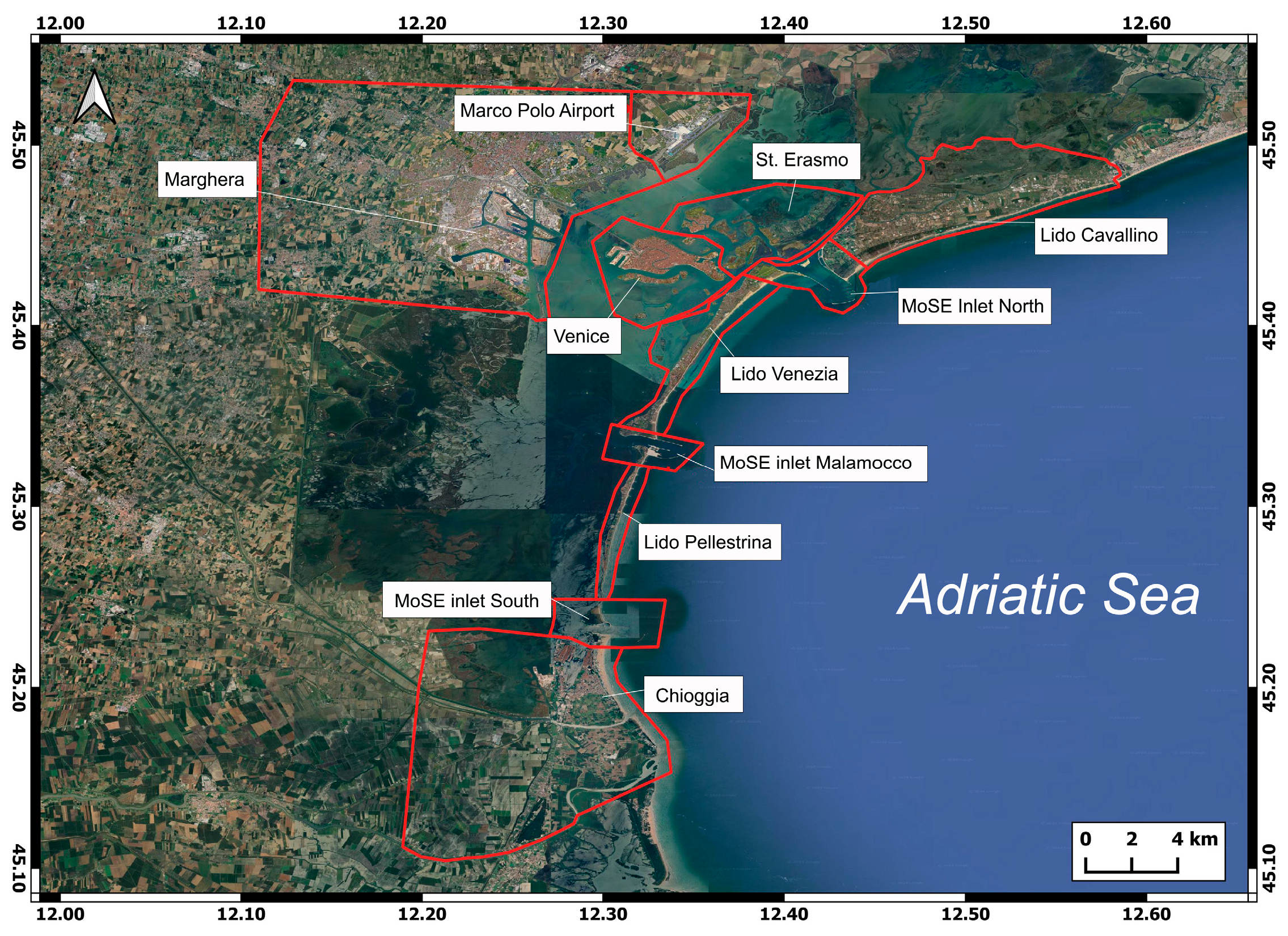


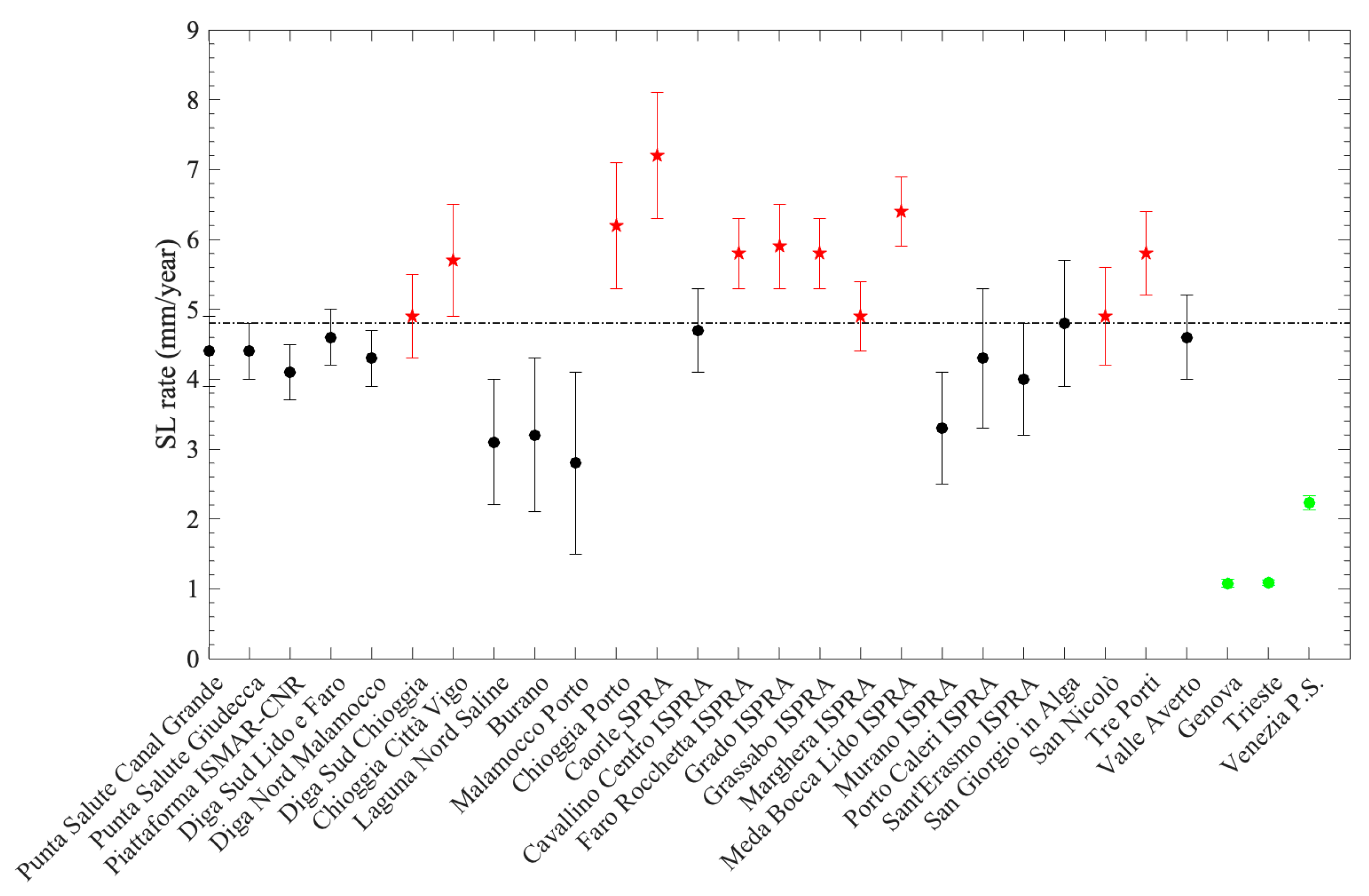
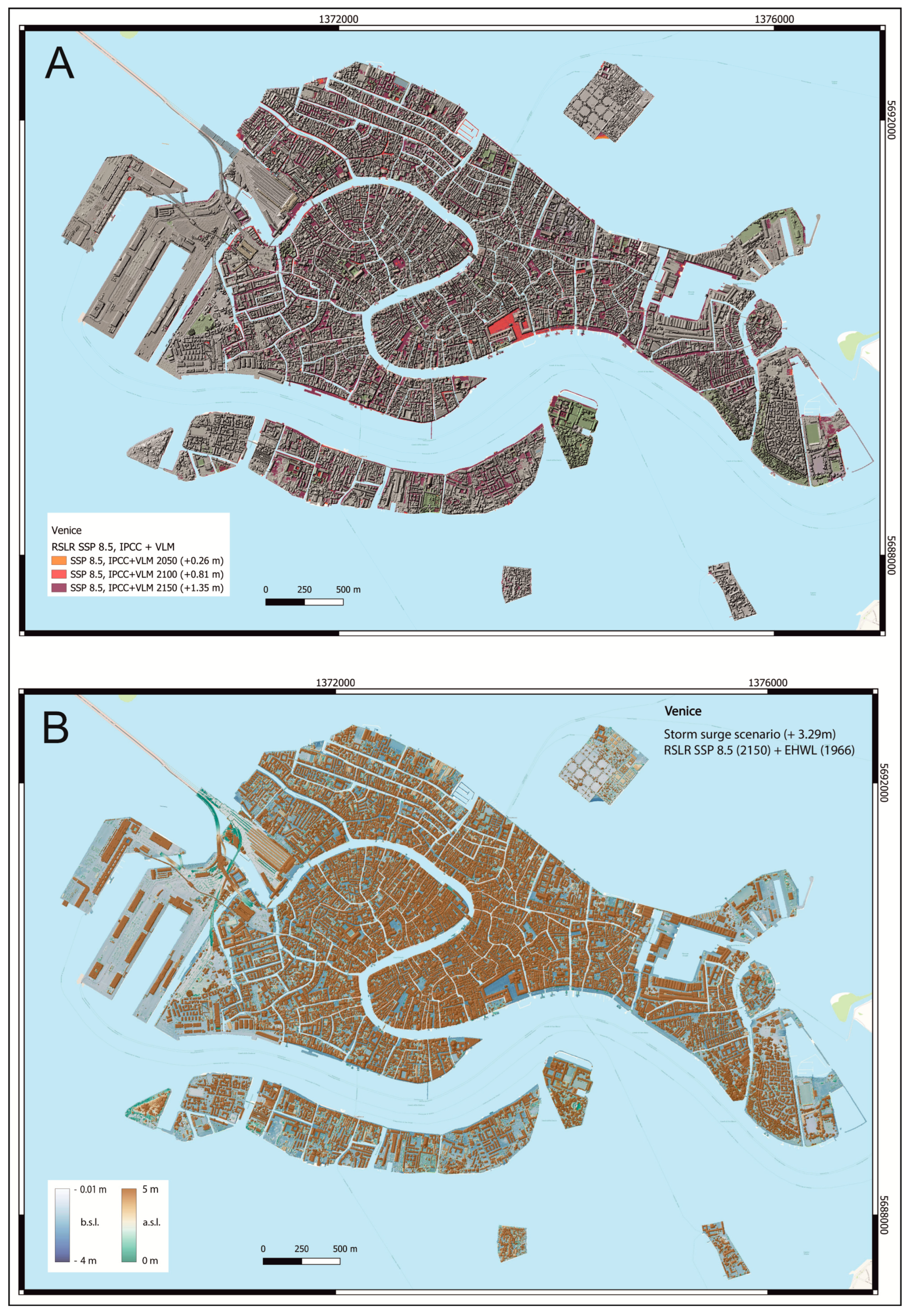

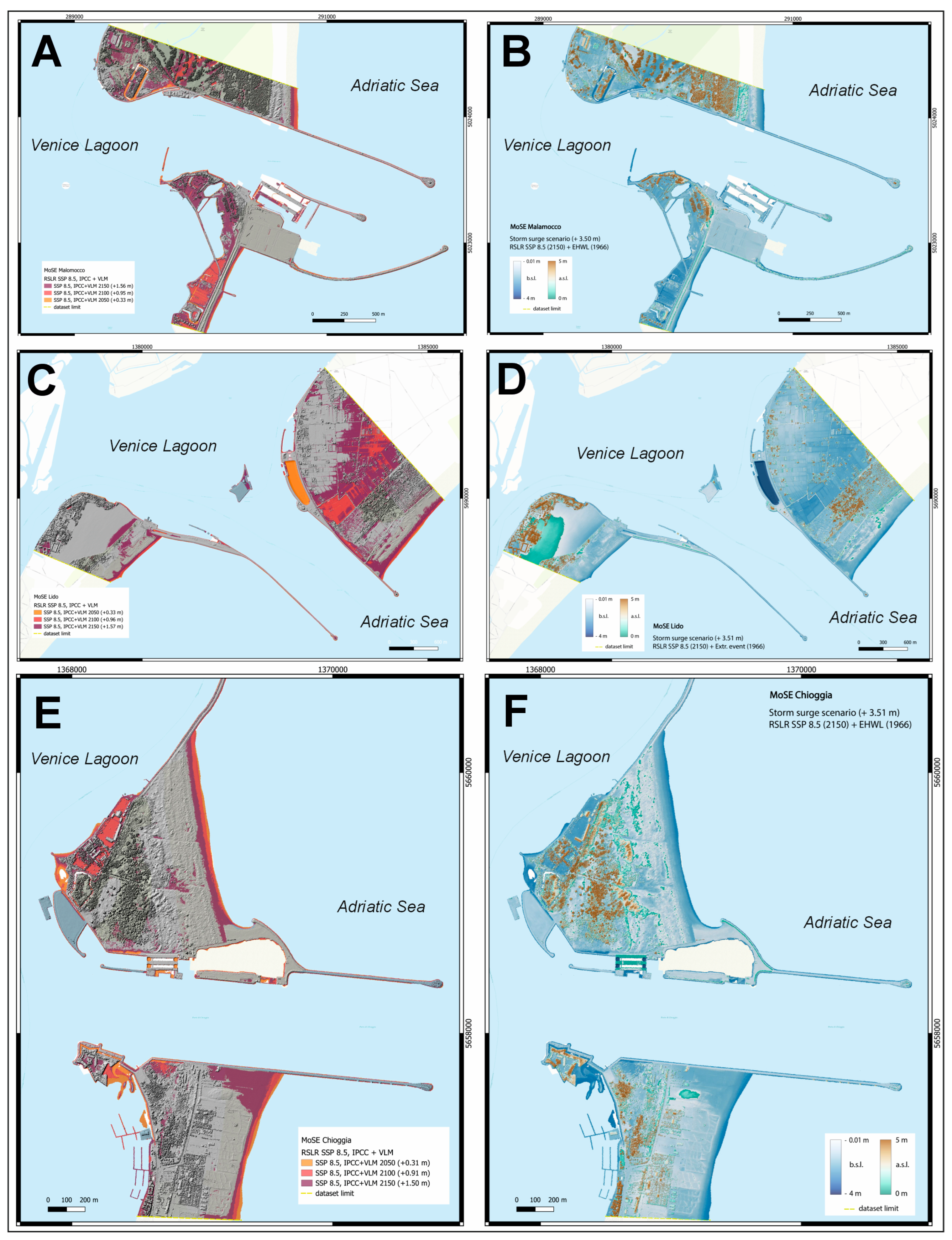
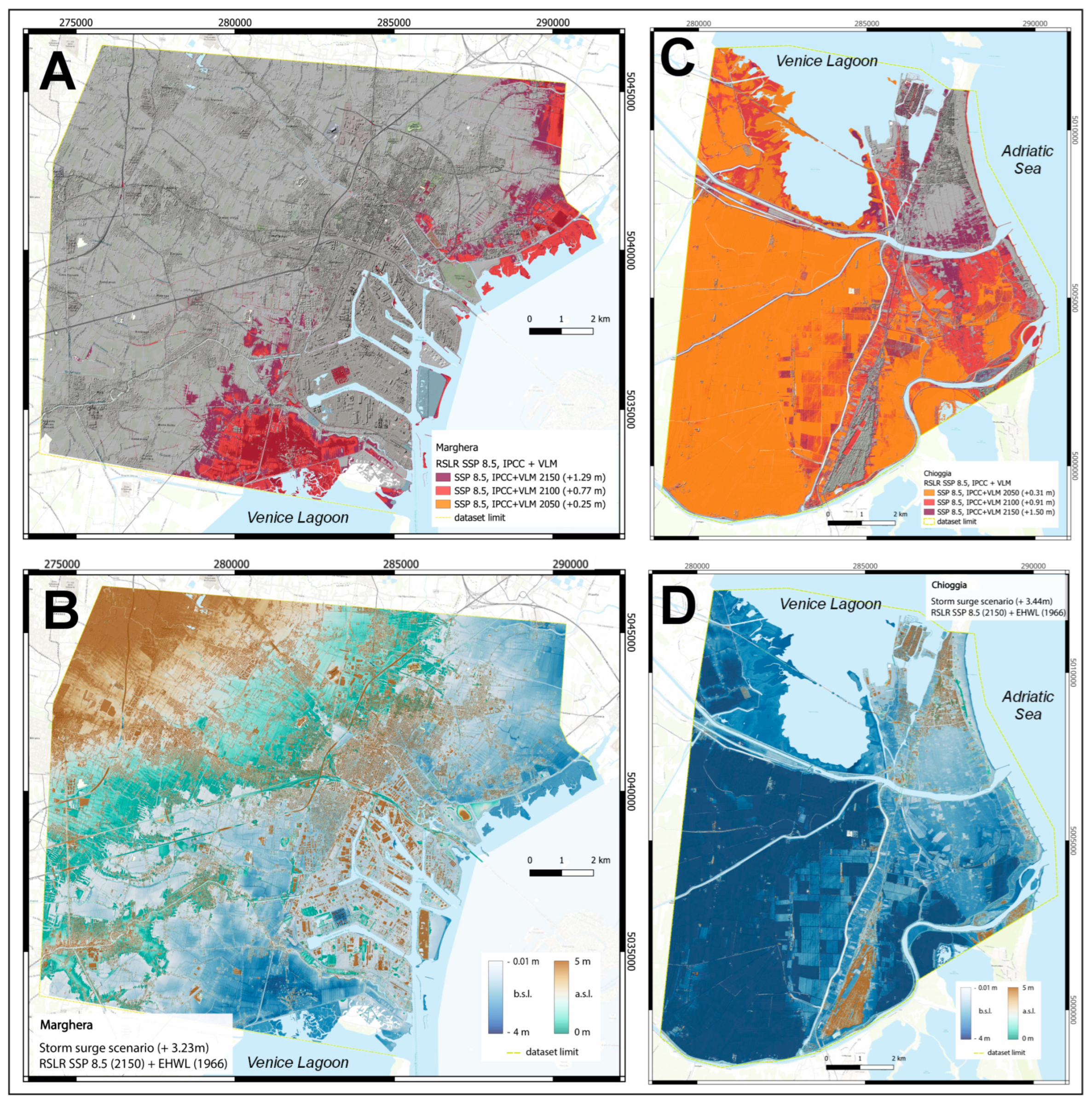

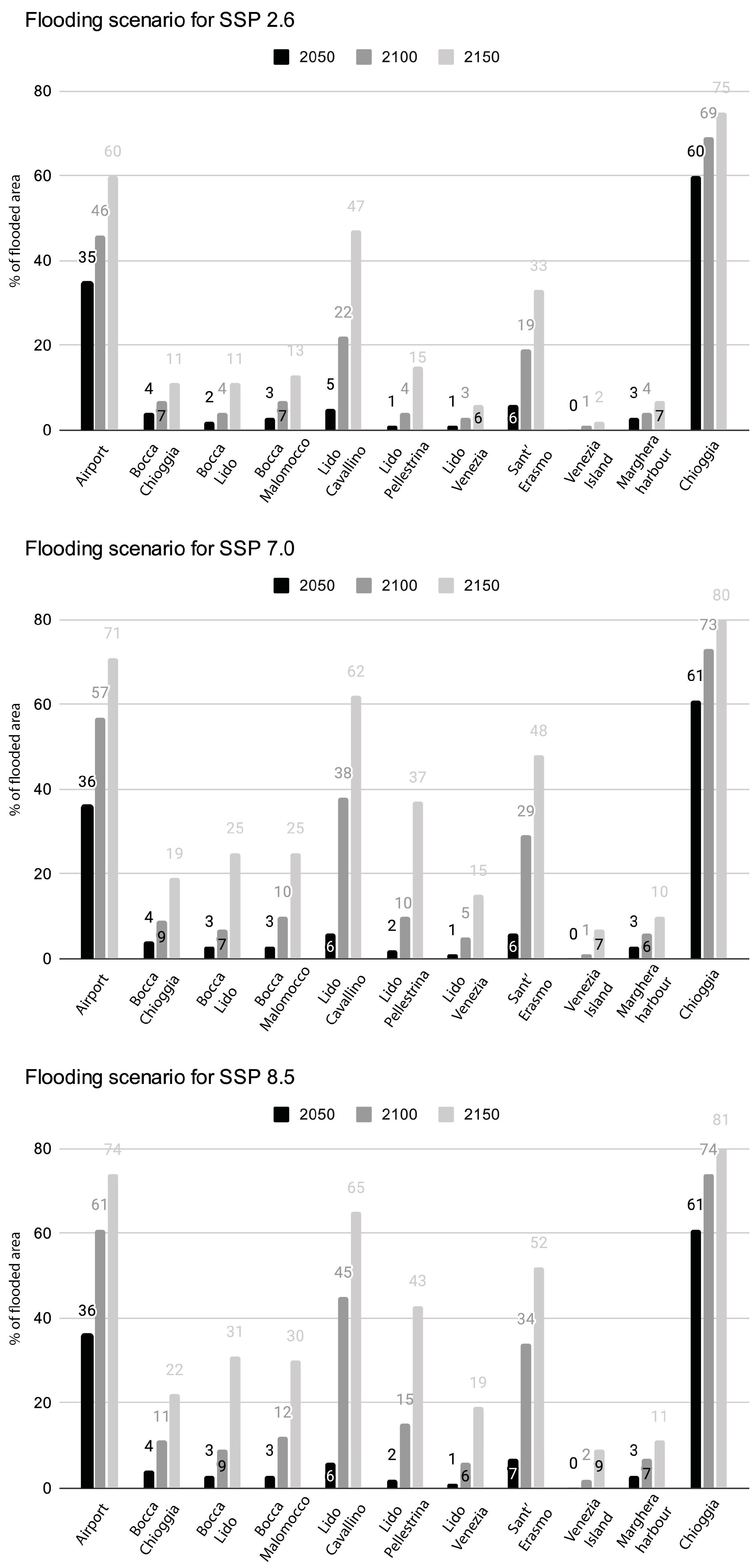

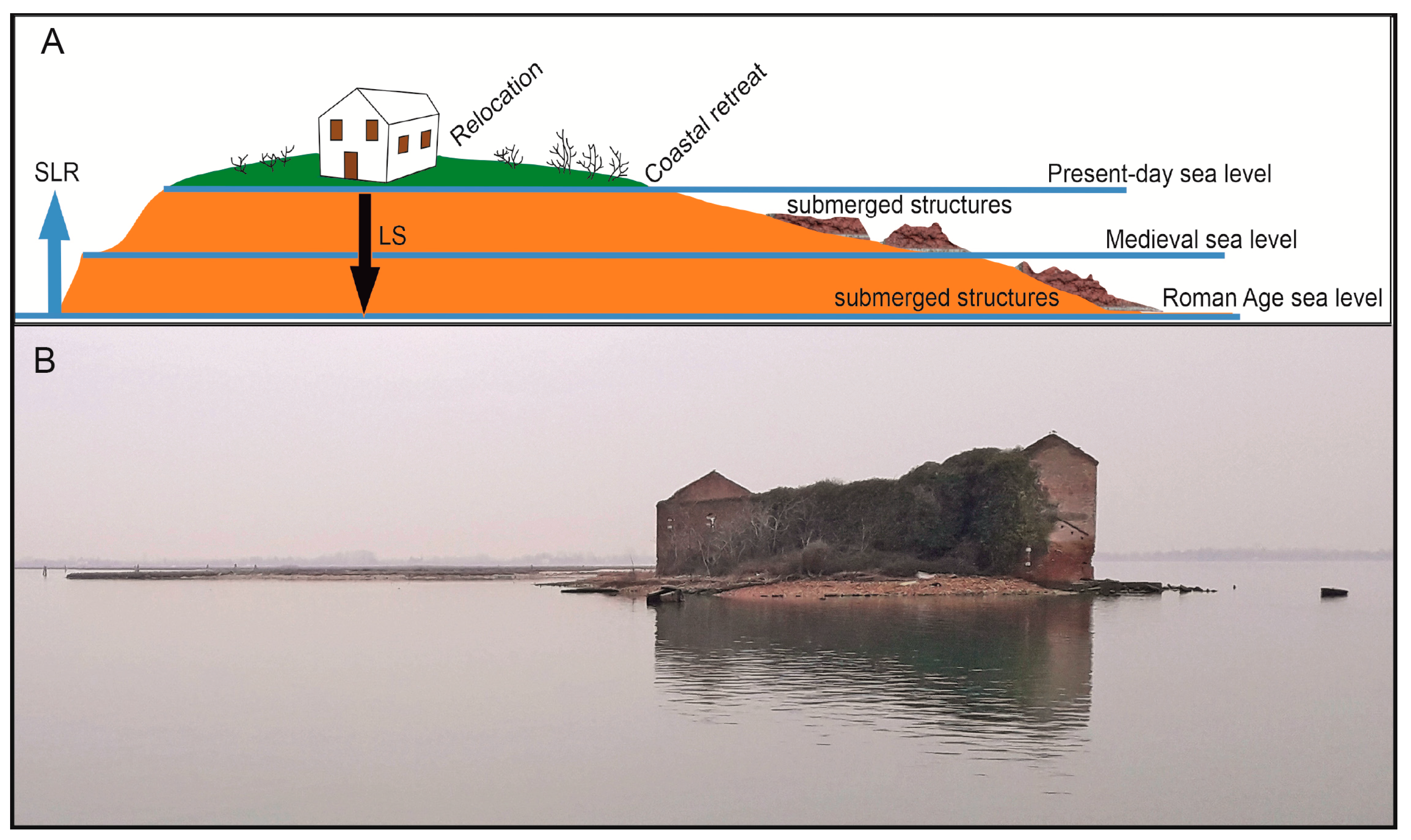
| Station Name | Lat | Lon | Vup (mm/yr) 1 | Sup (mm/yr) | Time (Years) |
|---|---|---|---|---|---|
| CAVA | 45.4794 | 12.5827 | −2.79 | 0.40 | 9.62 |
| CGIA | 45.2065 | 12.2655 | −2.21 | 0.33 | 12.85 |
| MIRA | 45.4976 | 12.0954 | −1.18 | 0.31 | 10.44 |
| MSTR | 45.4904 | 12.2386 | −2.86 | 0.52 | 6.74 |
| PSAL | 45.4307 | 12.3365 | −1.07 | 0.36 | 9.02 |
| VEAR | 45.4379 | 12.3578 | −2.29 | 1.07 | 4.56 |
| VEN1 | 45.4306 | 12.3541 | −1.41 | 0.23 | 15.57 |
| Site | Mean of All Areas | MoSE Chioggia | Chioggia | Venice | St. Erasmo Island | Marghera |
|---|---|---|---|---|---|---|
| Vup (mm/yr) | −1.93 | −2.4 | −2.4 | −1.4 | −1.4 | −0.9 |
| Site | MoSE Malamocco | Lido Venezia | Lido Cavallino | Lido Pellestrina | MoSE Lido | Airport |
| Vup (mm/yr) | −2.8 | −2.0 | −2.5 | −1.7 | −2.9 | −1.2 |
| IPCC Scenario | Year AD | IPCC SLR (cm) | VLM (InSAR) (cm) | RSLR (cm) |
|---|---|---|---|---|
| SSP1-2.6 | 2050 | 18 | 2–8 | 20–26 |
| 2100 | 41 | 7–22 | 48–63 | |
| 2150 | 60 | 11–37 | 71–97 | |
| SSP3-7.0 | 2050 | 20 | 2–8 | 22–28 |
| 2100 | 60 | 7–22 | 67–82 | |
| 2150 | 100 | 11–37 | 113–139 | |
| SSP5-8.5 | 2050 | 21 | 2–8 | 23–29 |
| 2100 | 69 | 7–22 | 76–91 | |
| 2150 | 116 | 11–37 | 127–153 |
| 2050 AD | 2100 AD | 2150 AD | |||||
|---|---|---|---|---|---|---|---|
| ID | Area | RSLR | FE | RSLR | FE | RSLR | FE |
| (a) SSP1–2.6 Scenario | |||||||
| 1 | Venice Island | 0.23 | 0.01 | 0.53 | 0.04 | 0.79 | 0.10 |
| 2 | St. Erasmo | 0.23 | 0.33 | 0.53 | 1.10 | 0.79 | 1.92 |
| 3 | Airport | 0.23 | 6.97 | 0.52 | 9.15 | 0.77 | 11.86 |
| 4 | MoSE Malamocco | 0.30 | 0.04 | 0.67 | 0.09 | 1.00 | 0.16 |
| 5 | MoSE Lido | 0.30 | 0.09 | 0.68 | 0.17 | 1.01 | 0.41 |
| 6 | MoSE Chioggia | 0.28 | 0.05 | 0.63 | 0.09 | 0.94 | 0.16 |
| 7 | Marghera | 0.22 | 4.51 | 0.49 | 7.83 | 0.73 | 11.90 |
| 8 | Lido Cavallino | 0.28 | 1.48 | 0.64 | 6.05 | 0.95 | 13.11 |
| 9 | Lido Pellestrina | 0.25 | 0.02 | 0.57 | 0.07 | 0.84 | 0.19 |
| 10 | Lido Venezia | 0.26 | 0.07 | 0.59 | 0.19 | 0.88 | 0.38 |
| 11 | Chioggia | 0.28 | 57.88 | 0.63 | 66.74 | 0.94 | 72.03 |
| (b) SSP3–7.0 Scenario | |||||||
| 1 | Venice Island | 0.25 | 0.01 | 0.72 | 0.08 | 1.21 | 0.47 |
| 2 | St. Erasmo | 0.25 | 0.37 | 0.72 | 1.72 | 1.21 | 2.82 |
| 3 | Airport | 0.25 | 7.11 | 0.71 | 11.28 | 1.19 | 14.01 |
| 4 | MoSE Malamocco | 0.32 | 0.04 | 0.86 | 0.12 | 1.42 | 0.31 |
| 5 | MoSE Lido | 0.32 | 0.10 | 0.87 | 0.26 | 1.43 | 0.97 |
| 6 | MoSE Chioggia | 0.30 | 0.05 | 0.82 | 0.13 | 1.36 | 0.27 |
| 7 | Marghera | 0.24 | 4.72 | 0.68 | 11.15 | 1.15 | 17.99 |
| 8 | Lido Cavallino | 0.30 | 1.64 | 0.83 | 10.66 | 1.37 | 17.22 |
| 9 | Lido Pellestrina | 0.27 | 0.25 | 0.76 | 0.14 | 1.26 | 0.61 |
| 10 | Lido Venezia | 0.28 | 0.08 | 0.78 | 0.30 | 1.30 | 0.96 |
| 11 | Chioggia | 0.30 | 58.31 | 0.82 | 70.47 | 1.36 | 76.73 |
| (c) SSP5–8.5 Scenario | |||||||
| 1 | Venice Island | 0.26 | 0.01 | 0.81 | 0.12 | 1.35 | 0.63 |
| 2 | St. Erasmo | 0.26 | 0.39 | 0.81 | 1.97 | 1.35 | 3.05 |
| 3 | Airport | 0.26 | 7.17 | 0.80 | 12.09 | 1.33 | 14.56 |
| 4 | MoSE Malamocco | 0.33 | 0.04 | 0.95 | 0.14 | 1.56 | 0.37 |
| 5 | MoSE Lido | 0.33 | 0.10 | 0.96 | 0.35 | 1.57 | 1.19 |
| 6 | MoSE Chioggia | 0.31 | 0.06 | 0.91 | 0.15 | 1.50 | 0.32 |
| 7 | Marghera | 0.25 | 4.82 | 0.77 | 12.48 | 1.29 | 20.47 |
| 8 | Lido Cavallino | 0.31 | 1.72 | 0.92 | 12.58 | 1.51 | 18.13 |
| 9 | Lido Pellestrina | 0.28 | 0.03 | 0.85 | 0.23 | 1.40 | 0.72 |
| 10 | Lido Venezia | 0.29 | 0.08 | 0.87 | 0.37 | 1.44 | 1.22 |
| 11 | Chioggia | 0.31 | 58.67 | 0.91 | 71.67 | 1.50 | 78.13 |
Disclaimer/Publisher’s Note: The statements, opinions and data contained in all publications are solely those of the individual author(s) and contributor(s) and not of MDPI and/or the editor(s). MDPI and/or the editor(s) disclaim responsibility for any injury to people or property resulting from any ideas, methods, instructions or products referred to in the content. |
© 2025 by the authors. Licensee MDPI, Basel, Switzerland. This article is an open access article distributed under the terms and conditions of the Creative Commons Attribution (CC BY) license (https://creativecommons.org/licenses/by/4.0/).
Share and Cite
Anzidei, M.; Tolomei, C.; Trippanera, D.; Alberti, T.; Bosman, A.; Brunori, C.A.; Serpelloni, E.; Vecchio, A.; Falciano, A.; Deli, G. Multi-Temporal Relative Sea Level Rise Scenarios up to 2150 for the Venice Lagoon (Italy). Remote Sens. 2025, 17, 820. https://doi.org/10.3390/rs17050820
Anzidei M, Tolomei C, Trippanera D, Alberti T, Bosman A, Brunori CA, Serpelloni E, Vecchio A, Falciano A, Deli G. Multi-Temporal Relative Sea Level Rise Scenarios up to 2150 for the Venice Lagoon (Italy). Remote Sensing. 2025; 17(5):820. https://doi.org/10.3390/rs17050820
Chicago/Turabian StyleAnzidei, Marco, Cristiano Tolomei, Daniele Trippanera, Tommaso Alberti, Alessandro Bosman, Carlo Alberto Brunori, Enrico Serpelloni, Antonio Vecchio, Antonio Falciano, and Giuliana Deli. 2025. "Multi-Temporal Relative Sea Level Rise Scenarios up to 2150 for the Venice Lagoon (Italy)" Remote Sensing 17, no. 5: 820. https://doi.org/10.3390/rs17050820
APA StyleAnzidei, M., Tolomei, C., Trippanera, D., Alberti, T., Bosman, A., Brunori, C. A., Serpelloni, E., Vecchio, A., Falciano, A., & Deli, G. (2025). Multi-Temporal Relative Sea Level Rise Scenarios up to 2150 for the Venice Lagoon (Italy). Remote Sensing, 17(5), 820. https://doi.org/10.3390/rs17050820








